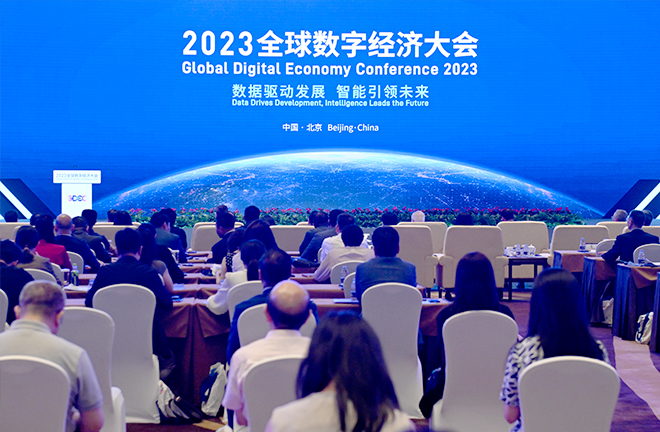Establish the principle of distributive justice for digital labor

Global Digital Economy Conference 2023 held from June 4-7 at the China National Convention Center in Beijing Photo: Tian Yuhao/CNSphoto
Against the backdrop of the accelerated development of the Internet, big data, and artificial intelligence, the digital economy has become an important engine driving economic development. To promote the healthy development of China’s digital economy, it is necessary to examine the new form of digital production, namely digital labor, and address its associated distribution challenges.
Digital transformation of labor
The rapid development of digital-intelligent technology beginning in the 21st century has enabled individuals to leverage novel digital production tools, leading to the digital transformation of labor.
In terms of origin, the technological underpinning of digital labor lies in the emergence of “new systems of machinery.” Digital labor is the process of transforming objects through new technologies such as the Internet of Things, artificial intelligence, blockchain, cloud computing, and 5G. The creation and application of these digital “new systems of machinery” has led to the gradual transformation of labor towards “intellectualization” and the emergence of digital labor.
In terms of process, the dominant model of digital labor is “human-machine interaction.” Digital machines and media serve as the technological precondition for digital labor, and conscious human beings are the subjects. People leverage their intelligence and creativity to encode, process, and transform “intangible things” such as data and information with the help of digital tools and media. It is a type of intellectual labor that goes beyond traditional physical labor, and transcends the field and spatial-temporal locality of labor.
In terms of outcomes, the ultimate purpose of digital labor is to create digital products by collecting, transmitting, encoding, analyzing, storing, and valuing “raw materials” such as data and information. These products will be traded in the form of signals, advertisements, software, cultural and creative products, and services. Ultimately, the value of digital labor is created and transferred. Digital labor is therefore a productive and creative activity.
New issues of distributive justice
Digital labor is a new business format that has emerged amid the rapid development of the digital economy. Certain signs of unhealthy and non-standard development have appeared due to the hidden control of digital capital, raising new issues of distributive justice.
The first issue is that of subjectivity. Humans are the subject of labor as they engage in production and manufacture the means of subsistence. In digital labor, human labor regulates the transformation relationship between humans, data, information, digital machines and other objects, with its content changing from physical to virtual. As digital labor gradually blurs the boundary between subject and object, physical and virtual, the “labor of digital machines” tends to obscure the “labor of humans,” leading to the “downgrading” of workers and even a crisis of subjectivity.
The second issue, ownership, arises from the fact that the instruments of labor, such as digital technology, platforms, applications, and software, are not considered public or common goods. As a result, users do not have ownership rights, and workers are often unable to receive their fair share of the benefits. On the other hand, workers’ digital activities usually generate massive data that, once processed and valued by platforms, become “general data” with exchange value, and eventually don’t belong to users.
Third, the issue of “divide” arises as we have observed variations in the abilities of digital workers, information asymmetry in the digital market, unequal distribution of digital industries, and wealth gaps in digital societies. These disparities stem from the uneven development of digital technology, asymmetric innovation, application and distribution of the digital means of production across regions and industries, and imbalanced adaptation and utilization of digital technology at the individual level.
Principles of distributive justice
To address the distribution issues of digital labor, it is necessary to establish principles of distributive justice tailored to the healthy development of the digital economy and the goal of common prosperity.
The first principle to consider is the principle of “prioritizing people,” which advocates the priority of people over things. Regardless of how digital technology is “integrated” with human labor, people are still the subject of the relations of production constructed through digital technology. Therefore, we should insist on treating people as the main factor of digital labor, and distributing rewards according to people’s work.
We should adhere to the principles of “equal ownership” of the digital means of production and distribution of digital products according to work. It is particularly important to prevent monopolies in digital platforms and the disorderly expansion of digital capital. The ownership issue of digital labor necessitates accelerating the establishment of basic institutional arrangements for data, creating a data property rights system, and improving the system for protecting the rights and interests embedded in data factors.
The “data sharing” mechanism for distribution practices is aimed at curbing the privatization of public data and the capitalization of personal data, and reducing the gaps in digital labor. The establishment of this mechanism requires us to develop the industrial and value chains of digital benefit sharing, promote the joint creation and sharing of digital resources, and encourage value compensation regarding public data. This can help narrow the digital divide and increase the accessibility of the digital economy so that members at different development stages share the fruits of digital labor.
Gong Yongdan is a research fellow in the Research Base of Party Building for Capital Universities at Beihang University.
Edited by WANG YOURAN
